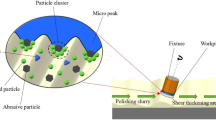Abstract
The recovery of silver from X-ray film processing effluents by precipitation using hydrogen peroxide as the precipitating agent was studied. Response surface methodology (RSM) and central composite design (CCD) were applied to achieve optimum conditions. Linear, square and interactions effects between parameters to study of a second order polynomial equation were obtained. Optimum condition included the volume of H2O2 0.8 ml/min, pH=5.5, ethylene glycol 9 ml in the experimental condition. In these conditions silver recovery percentage was predicted as 92.8%. The experiment was conducted in triplicate under optimized conditions. Silver recovery percentage and average of precipitate were obtained as 91.5% and 423.19mg, respectively, which were close to the predicted amount achieved by the model.
Similar content being viewed by others
References
O. N. Kononova, A. G. Kholmogorov, N. V. Danilenko, N. G. Goryaeva, K. A. Shatnykh and S.V. Kachin, Hydrometallurgy, 88, 189 (2007).
S. Syed, S. Suresha, L.M. Sharma and A. A. Syed, Hydrometallurgy, 63, 277 (2002).
S. A. Bolorunduro, Miner. Eng., 16, 695 (2003).
J. Nan, D. Han, M. Yang, M. Cui and X. Hou, Hydrometallurgy, 84, 75 (2006).
Y. Pranolo, W. Zhang and C.Y. Cheng, Hydrometallurgy, 102, 37 (2010).
Y. J. Park and D. J. Fray, J. Hazard. Mater., 164, 1152 (2009).
N. Nakibo lu, D. Toscal and G. Nisli, Turk. J. Chem., 27, 127 (2003).
I. Rivera, A. Roca, M. Cruells, F. Patino and E. Salinas, Hydrometallurgy, 89, 89 (2007).
N. Sathaiyan, V. Nandakumar and P. Ramachandran, J. Power Sources, 161, 1463 (2006).
J. P. Chen and L. L. Lim, Chemosphere, 60, 1384 (2005).
A. Troupis, A. Hiskia and E. Papaconstantinou, Appl. Catal., B 42, 305 (2003).
V. Stankovic, L. Outarra, F. Zonnevijlle and C. Comninellis, Sep. Purif. Technol., 61, 366 (2008).
K.G. Adani, R.W. Barley and R. D. Pascoe, Miner. Eng., 18, 1269 (2005).
S. Aktas, Can. Metall. Q., 47, 37 (2008).
J. F. Blais, Z. Djedidi, R. B. Cheikh, R. D. Tyagi and G. Mercier, Journal of Hazardous Toxic and Radioactive Waste, 12, 135 (2008).
P. E. Tsakiridis, P. Oustadakis and S. Agatzini-Leonardou, J. Environ. Chem. Eng., http://dx.doi.org/10.1016/j.jece.2013.03.004 (2013).
E.Y. Yazici, H. Deveci and R. Yazici, Sep. Sci. Technol., 46, 2231 (2011).
F. Fourcade, T. Tzedakis and A. Bergel, Chem. Eng. Sci., 58, 3507 (2003).
S. Shankar, S.V. More and R. Seeta Laxman, Kathmandu University Journal of Science, Engineering and Technology, 6, 60 (2010).
V. Ortiz, M. Angélica Rubio and E. A. Lissi, Atmospheric Environment, 34, 1139 (2000).
A. Karimi, F. Mahdizadeh and M.R. Eskandarian, Chem. Ind. Chem. Eng. Q., 18, 89 (2012).
M.R. Eskandarian, A. Karimi and M. R. Shabgard, J. Taiwan Ins. Chem. Eng., 44, 331 (2013).
C.W. Jones, Applications of hydrogen peroxide and derivatives, RSC Clean Technology Monographs, The Royal Society of Chemistry, Cambridge, U.K., 282 (1999).
A. D. Bas, E.Y. Yazici and H. Deveci, Hydrometallurgy, 121–124, 1 (2012).
S. S. Bhattacharya and R. Banerjee, Chemosphere, 73, 81 (2008).
L. Mohajeri, H. Abdul Aziz, M. Ali Zahed, S. Mohajeri, S. Rahman, K. Mohamed and M. Hasnain Isa, Water Sci. Technol., 63, 618 (2011).
M. Ahmadi, F. Vahabzadeh, B. bonakdarpour, E. Mofarrah and M. Mehranian, J. Hazard. Mater., 123, 187 (2005).
A. Karimi, F. Mahdizadeh, D. Salari, F. Vahabzadeh and A.R. Khataee, Chem. Ind. Chem. Eng. Q., 18, 431 (2012).
M.R. Eskandarian, F. Mahdizadeh, L. Ghalamchi and S. Naghavi, Desalin. Water Treat., 22, 1 (2013).
W. Djoudi, F. Aissani-Benissad and S. Bourouina-Bacha, Chem. Eng. J., 133, 1 (2007).
Z. Salehi, F. Vahabzadeh, M. Sohrabi, Sh. Fatemi and H. Tawfig Zand, Biodegradation, 21, 645 (2010).
M. Zarei, A. Niaei, D. Salari and A. Khataee, J. Hazard. Mater., 173, 544 (2010).
M. Anderson and P. Whitcomb, DOE simplified: practical tools for effective experimentation, 2nd Ed., Productivity Press, New York (2007).
A. Kumar, B. Prasad and I. M. Mishra, Can. J. Chem. Eng., 87, 637 (2009).
Author information
Authors and Affiliations
Corresponding author
Rights and permissions
About this article
Cite this article
Mahdizadeh, F., Eskandarian, M., Zabarjadi, J. et al. Silver recovery from radiographic film processing effluents by hydrogen peroxide: Modeling and optimization using response surface methodology. Korean J. Chem. Eng. 31, 74–80 (2014). https://doi.org/10.1007/s11814-013-0174-9
Received:
Accepted:
Published:
Issue Date:
DOI: https://doi.org/10.1007/s11814-013-0174-9




